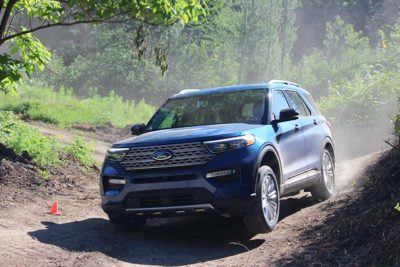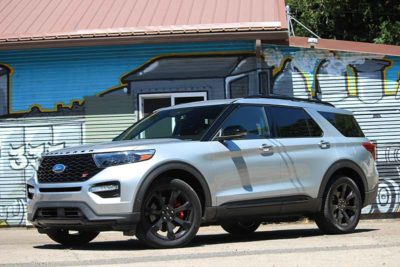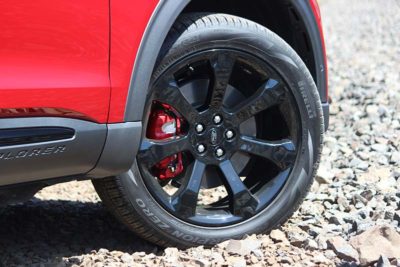First Drive: 2020 Ford Explorer


2020 marks the debut of a new platform for the Explorer, one that gets its start as a RWD platform as opposed to an FWD one. While we’ll only be getting the AWD version in Canada across the four trims – XLT ($45,199), Limited ($52,199), Platinum ($64,599) and ST ($59,099) – the fact that it starts out as a RWD system means that it’s much more likely to send power to the rear wheels unless the fronts need it – usually when slip’s detected. Used to be the other way ‘round, but this is a new day.
In addition to the ST, another big addition for 2020 is that of a hybrid powertrain option (Limited trim only, for $57,199), but not just any hybrid powertrain option: this one has been built so that it can do all the work the non-hybrid versions can – more on how in a minute.
More than just a new platform, the 2020 Explorer gets a host of styling adds including an entirely new front fascia with optional LED headlights and DRLs, three grill choices depending on which model you choose, new wheel choices and new colours both inside and out. The rear fascia of non-ST models doesn’t look quite as different from previous as the front does (there are a pair of new taillights, and that’s about it), but the profile view is cleaner now that the gap between the hood and front fenders has been moved atop the hood, instead of above the front fenders. The ST gets an added rear diffuser and quad exhaust outlets.
Inside, there’s a host of new stuff but the addition most are likely going to notice is the touchscreen display on the higher Platinum and ST trims. Like what’s seen in Volvos, Teslas and more recently, the Ram 1500, the display in the Explorer is now vertical. That makes scrolling through menus easier (and more can be fit on-screen) but the way it’s mounted makes it look like a tablet is docked there.

It’s your gateway to either a six-speaker or optional 12-speaker Bang & Olufsen sound system. The latter provides rich sound with speakers that don’t vibrate at all even when the base gets heavy, while crisp midrange and treble all combine to demonstrate how B & O worked with Ford from the get-go to ensure that their system was as compatible with the Explorer as possible. Of course Apple CarPlay and Android Auto also come as standard. Also available is a digital gauge cluster that has a different look depending on which drive mode you’re in, and displays different info as well. Tow mode, for example, brings the temp gauge and tach to prominence, while sport mode in the ST gives the gauges a red hue and sports a traditional analogue speed/rpm display.
While I probably knew in my heart of hearts that Ford wouldn’t release the Hybrid if it wasn’t capable, I was still surprised by just how capable it felt, and so much of it is down to that transmission that’s been developed from the standard 10-speed, just with a few nips and tucks to make it work in a hybrid format. By keeping the 10-speed, though, they managed to keep the capability because according to Ford, the Hybrid should be used just as regularly and for just the same tasks as any other variant. That means it can still tow, it can carry just as many people and it doesn’t lose cargo room. The bottom line, however, is the extra weight that the hybrid takes on means it can’t tow quite as much; it’s limited to 5,000 lbs., while the 2.7L and 3.0L models can haul 5,300 and 5,600, respectively. It’s not that the Hybrid can’t tow more, it’s just that, legally, it’s not allowed to.
Power from the 2.3L is rated at 300 hp and 310 lb-ft, channeled to all four wheels (but usually just the back two, as mentioned earlier) via a 10-speed automatic transmission choice – the only option you can get on the 2020 Explorer.

Handling-wise, the Explorer comes with a number of drive modes that affect the way power gets distributed, how heavy the steering is and so forth but in order for all of that to work, you need to start with a well-engineered platform. Ford has done so with the Explorer, providing a chassis that keeps body roll in check even with the responsive steering it provides. Not overly autocross-ready responsive, of course, but enough to help you quickly avoid road obstructions and so forth. The Explorer provides that, as well as the easy power required to help its case as the perfect family road-trip vehicle.
When it comes to which model benefits most from the transition to RWD, you have to think the ST takes the cake. Sure; all models benefit from the tighter turning radius provided by a RWD bias, but as you start to push the ST through the bends as we did through the Cascade mountains in Washington, you can really see what the switch as done.

For the Hybrid test, I did things a little backward in that I hooked the Hybrid up to a 4,500 lb. boat and trailer and actually tested its towing chops before I tested it unburdened. On top of that, I also had the chance to take it on a small off-road course before the open road as well; there’s something quite strange about driving on a 25-degree angle (you can tell because the digital gauge cluster displays this), but with no engine noise because you’re in EV mode.
That’s not something that ever happened when towing, though – in fact, it’s not something that will ever happen in towing because the EV portion of the powertrain can’t quite cope with that load. Coped just fine in hybrid mode, however, even over the few grades we attempted on our route.
It’s interesting because it’s actually when unburdened that you feel the biggest difference, because it’s here that you can really notice the weight difference between the Hybrid and the 2.3, which is an additional 300 pounds or so. As result, the Hybrid takes a little longer to change directions, a little longer to get going even if it does make more power (318 hp combined) and torque (322 lb-ft) than do 2.3L EcoBoost models.
Which is fine in the numbers sense, I guess, but the real story of the Hybrid model is its capability and while EV trucks and SUVs are on the very near horizon, this particular hybrid remains an attractive choice. It’s just a shame that it’s available only on the Limited trim; perhaps it will filter down the range after Ford looks at sales over the first year or two.
The Explorer’s sales over the years have shown that it’s always been the attractive choice, and you have to think that this newfound focus on a complete line-up – from Hybrid to ST – will raise the Explorer’s brand profile that much more in buyers’ eyes. I know I stood up and took notice.




























